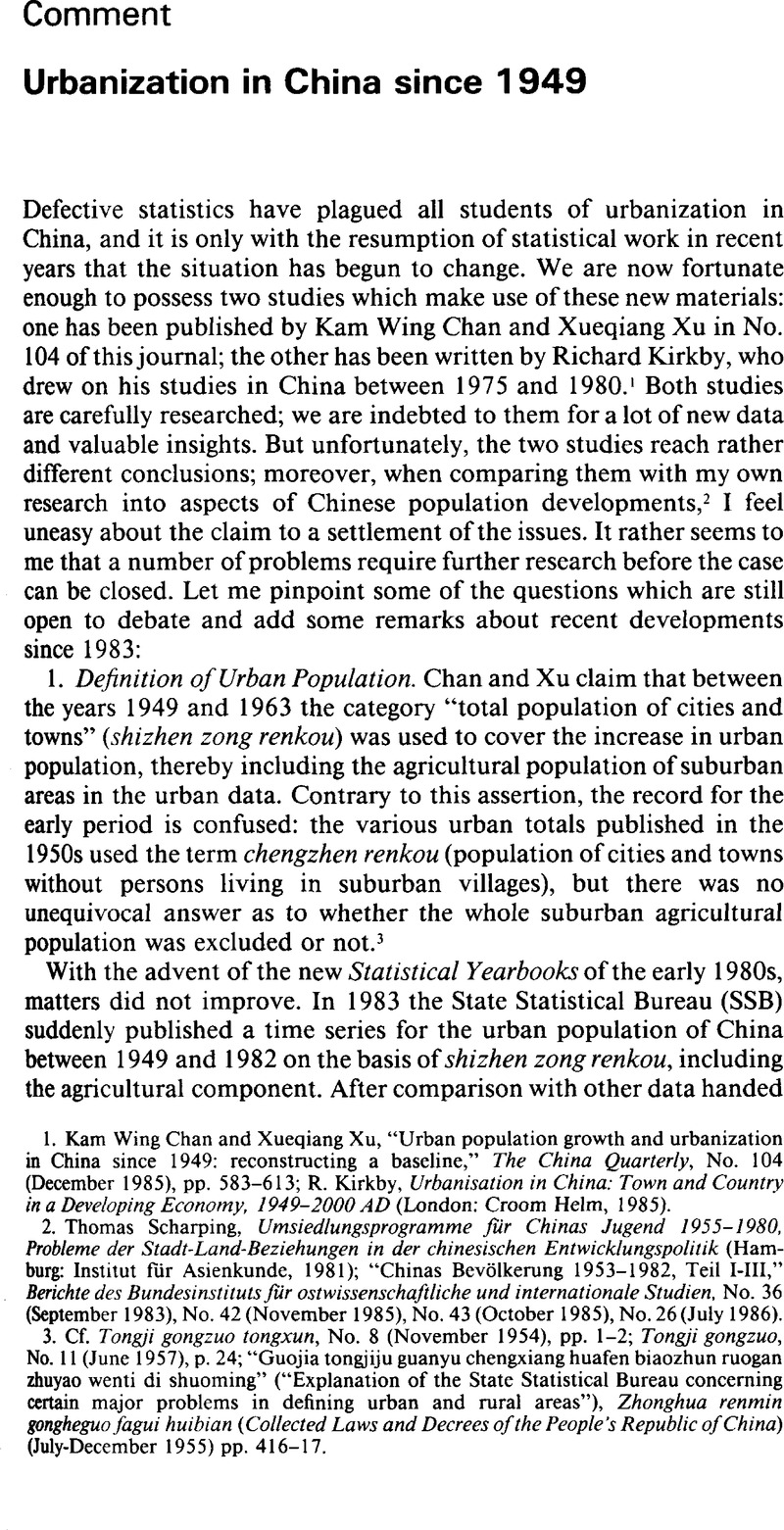Article contents
Urbanization in China since 1949
Published online by Cambridge University Press: 17 February 2009
Abstract

- Type
- Comment
- Information
- Copyright
- Copyright © The China Quarterly 1987
References
1. Chan, Kam Wing and Xueqiang, Xu, “Urban population growth and urbanization in China since 1949: reconstructing a baseline,” The China Quarterly, No. 104 (12 1985), pp. 583–613;CrossRefGoogle ScholarKirkby, R., Urbanisation in China: Town and Country in a Developing Economy, 1949-2000 AD (London: Croom Helm, 1985).Google Scholar
2. Thomas, Scharping, Umsiedlungsprogramme für Chinas Jugend 1955-1980, Probleme der Stadt-Land-Beziehungen in der chinesischen Entwicklungspolitik (Hamburg: Institut fur Asienkunde, 1981);Google Scholar “Chinas Bevölkerung 1953–1982, Teil I-III,” Berichte des Bundesinstituts für ostwissenschaftliche und internationale Studien, No. 36 (September 1983), No. 42 (November 1985), No. 43 (October 1985), No. 26 (July 1986).
3. Cf. Tongji gongzuo tongxun, No. 8 (November 1954), pp. 1–2; Tongji gongzuo, No. 11 (June 1957), p. 24; “Guojia tongjiju guanyu chengxiang huafen biaozhun ruogan zhuyao wenti di shuoming” (“Explanation of the State Statistical Bureau concerning certain major problems in defining urban and rural areas”), Zhonghua renmin gongheguo fagui huibian (Collected Laws and Decrees of the People's Republic of China) (July-December 1955) pp. 416–17.
4. World Bank (ed.), China: Socialist Economic Development, Annex B (Washington, D.C.: 1981), pp. 65–66, 76.
5. Kam Wing Chan and Xueqiang Xu, “Urban population growth,” pp. 597, 603, Tables 3 and 5. Zhongguo tongji nianjian 1981 (Statistical Yearbook of China, 1981) included the census figure for the urban total of 1953; the editions of 1983 and 1984 deleted it.
6. Kam Wing Chan and Xueqiang Xu, “Urban population growth,” p. 595; R. Kirkby, Urbanisation in China, pp. 107–124.
7. Zhongguo tongji nianjian 1984, p. 81; Renmin ribao (People's Daily), 5 December 1984.
8. Ullman, Morris B., Cities of Mainland China: 1953-1959 (Washington, D.C.: 1961);Google ScholarErnest, Ni, Distribution of the Urban and Rural Population of Mainland China: 1953 and 1953 (Washington, D.C.: 1960).Google Scholar
9. . Cf. World Bank (ed.), China, Annex B, p. 77; Zhongguo baike nianjian (China's Encyclopaedia Yearbook) (Beijing: 1980, 1981).
10. “Guowuyuan pizhuan minzhengbu guanyu tiaozheng jianzhen biaozhun di baogao di tongzhi” (“Directive of the State Council on the report of the Ministry of the Interior concerning the adjustment criteria for establishing townships”), Zhonghua renmin gongheguo guowuyuan gongbao (Bulletin of the State Council of the People's Republic of China), No. 30 (December 1984), pp. 1012–14.
11. Cf. inter alia Feng, Lanrui, Laodong baochou yu laodong jiuye (Labour Remuneration and Employment) (Beijing: Zhongguo zhanwang chubanshe, 1982), pp. 115–16.Google Scholar
12. Kam Wing Chan and Xueqiang Xu, “Urban population growth,” pp. 606–607. The authors draw on Wu, Youren, “Guanyu woguo shehuizhuyi chengshihua wenti” (“Concerning problems of China's socialist urbanization”), in Beijing jingji xueyuan (ed), Zhongguo renkou kexue lunji (Symposium on China's Population) (Beijing: Zhongguo xueshu chubanshe, 1981), p. 97. This source again does not provide any fiirther details.Google Scholar
13. An example is Jack, Chen, A Year in Upper Felicity (New York: Macmillan, 1973).Google Scholar
- 6
- Cited by




